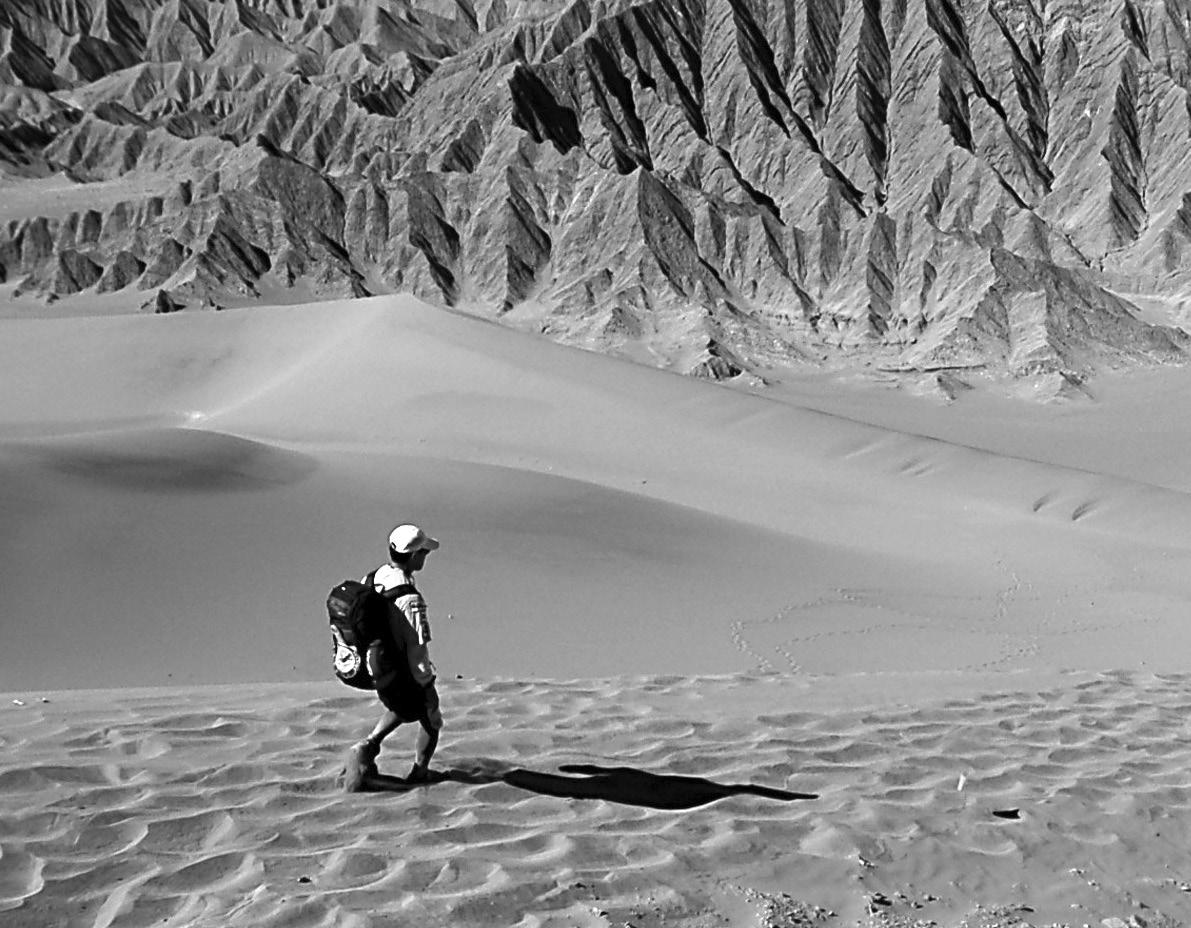
23 minute read
AUSTRALIAN CHAMPS CARNIVAL
Great Performances
in the West
Blair Trewin
THE carnival started with the WA Championships, a two-day affair at Darkin River, east of Perth, which saw the full range of terrain, from open, fast, vague areas, to steep rocky slopes which provided the week’s toughest physical terrain. A distraction for some (especially the locals) was the AFL Grand Final, which took place during the event on Saturday afternoon. Jo Allison won both days to open up her National League chances. On the first day her closest rival was Shannon Jones, enjoying her best year at this level, but no-one was able to match her consistently and by the end of the second day she was more than ten minutes ahead. Ten minutes covered the next eight, with Anna Sheldon’s strong second half on the long second day – an indicator of what she was to produce six days later – seeing her take second ahead of Susanne Casanova. A large part of the M21 field struck trouble at the second control on Day 1 – which was sufficiently doubtful to trigger a (dismissed) protest. Dave Shepherd lost time there and more over the following controls, and withdrew. Julian Dent also lost time there, enough to prevent him from winning the first day (which was taken out by Grant Bluett), but he became increasingly dominant the longer the second day went on, pulling away from Rob Walter over the last third of the course to secure a comfortable victory, with Bluett third and daylight between them and the rest. It was to be Walter’s last race of the carnival, thanks to a bike accident on Rottnest Island the next day. Ryan Smyth made a slow start on the first day but took control of M17-20E in the second half of the second day, pulling away from Chris Naunton and Murray Scown, who were separated by nine second on the first day and nothing on the second. Vanessa Round also made a slow start, losing time on a long leg on the first day, but she hit the front late on that course, and then held off a fast-finishing Sarah Dunnage on the second day. Elsewhere, some of the more interesting classes were W45, where Anthea Feaver and Jenny Bourne swapped narrow day wins but Feaver came out just on top; M16, where Lachlan Dow led a group of five within just over three minutes; and M45, where Mark Darvodelsky came from three minutes down on the first day to take victory over Darryl Smith at the last control.
Australian Schools Champs, Peterdine Hill, 3-4 October
Queensland and the ACT were equal winners of the Australian Schools Championships after a dramatic Relay day. It was a repeat of the result from 15 years ago, and once again the result was settled by the protest jury rather than in the forest. This time, it was the reinstatement of a disqualified Tasmanian team which pushed the Queensland senior girls back to third, and dropped them back into a tie after initially appearing to have won by a point. The New Zealanders were again dominant players with many top-ten results, but Thomas Reynolds was their only individual winner. For the first half of the senior boys he was in a close tussle with Nick Andrewartha and Bryan Keely, but Keely lost three minutes at #8 to drop back into the bunch (recovering with a strong finish to take third), and Reynolds gradually pulled away from Andrewartha over the closing stages to win by three minutes. Heather Harding completed a fine Schools career with her third win in four years – only two New Zealanders in 2005 stopped her from making it four in a row. Only Jo Allison, with five wins from 1989 to 1994, has done better. Harding was never seriously challenged; she had opened up a three-minute lead by halfway and held it to the end. Emma Watson emerged from the bunch with a good second half, whilst Catherine Hewitt recovered from an early mistake to take an unexpected second place. There was a fine three-way tussle in the junior boys which was not settled until the very end of the day. Lachlan Dow, Oscar Phillips and Scott McDonald were only separated by seconds at the spectator control, but it was the superior finishing speed of Phillips – a Tasmanian junior cross-country representative – that held sway in the end. Laura Robertson, only a first-year W14, set the pace for a long time for the New Zealanders. It looked as if she might hold on for the win, but a two-minute mistake at the end proved costly, and she dropped to third. Belinda Lawford was first to finish ahead of her with a consistent run, but Krystal Neumann had been a little ahead of her through the course, and finished off well for her second successive win. Relays day at the Australian Schools Championships rarely passes without incident, and 2006 was certainly no exception. Four states started it within some sort of range of the title, with a fifth (NSW) within remote reach if they had a very good relay. New South Wales indeed made an excellent start – after the first leg, they were the leading state team in two classes and second in another. That was the end of their challenge, and whilst the New Zealanders were taking overall control for a second day in a row, the ACT were setting up an excellent position to win the state competition. First Lachlan Dow came from 12 minutes down to run over the top of Queensland and New South Wales in the junior boys (Joshua Neumann outsprinted Thomas Carter to give Queensland second, a result which was critical to the overall score), then their two senior teams got into winning positions. Heather Harding never looked like letting the senior girls’ slip, but it was a different situation in the senior boys, where littleknown Michael Pfeifer was defending a five-minute lead over the individual winner Nick Andrewartha. Pfeifer did a better job than anyone dared expect, and whilst Andrewartha made some inroads towards the end, it was not enough to stop the ACT scoring an unexpected win. That gave the ACT the clubhouse lead. Queensland, who had been the leading state team in the junior girls, still had their two senior teams on the course. They needed a second and a third to win, or two thirds (or a second and a fourth) to tie, and started the final leg in third (girls) and fourth (boys). At the spectator control Bridget Anderson had moved up to second, after making up a seven-minute gap to New South Wales, whilst Simon


Mee was still in fourth, but only a minute behind Tom Dose for South Australia. The issue was settled at the second-last control, where Mee – who ran the fastest leg of the day – finally caught and passed Dose to take third, and when Anderson came in seven minutes later in second, Queensland celebrated overall victory – until the Tasmanians were reinstated (after mispunching on a pair of controls which were ruled to be illegally close together). New Zealand were again comfortable winners of the Southern Cross Junior Challenge. They would have won even had the disqualification of their senior boys’ team stood, but once they were reinstated their margin was extended to a commanding 11 points. Julian Dent made it two wins in a row in the National League, with a comfortable win over Dave Shepherd and Kerrin Rattray, whilst Anna Quayle kept her slim National League hopes alive with a win over Jo Allison in W21E. Ryan Smyth also continued his very impressive form, winning M17-20E in a time good enough for fifth in the senior race.
Australian Sprint Championships, York, 5 October
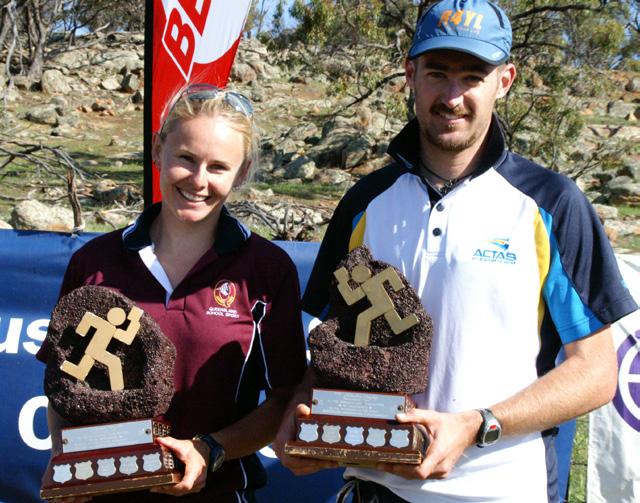
Julian Dent continued his great week with a win in the Australian Sprint Championships, taking the title by the substantial (by sprint standards) margin of 19 seconds as Orienteering took over the main street of York. He set up a useful lead in the first half of the course, and by halfway it was apparent that as long as he could hold it together he was going to win without too much trouble. Dave Shepherd was his nearest challenger, with Grant Bluett in third place. W21E was a two-way contest between Grace Elson, running her first race of the week, and Anna Quayle, with the pair a minute clear of the nearest opposition. Elson led for most of the first half but slipped behind with a 20-second error at #11. From then on they were only separated by seconds. Elson regained the lead by a second at the third-last and was able to hold on for a fivesecond win. Allison Jones withstood a late charge from her sister Shannon to hold third, whilst Jo Allison’s fifth ended any chance she had of taking the National League. Ryan Smyth again impressed in taking out M17-20E, establishing a 20-second lead inside the first four minutes and never being threatened thereafter. His closest opposition came from two New Zealanders, Thomas Reynolds and Simon Jager. They both recovered from slow starts to take the minor placings, after Murray Scown lost time over the closing stages to miss out on a chance at second. W17-20E also saw the lead Australian pursued by two New Zealanders. It was a closer contest, in which Vanessa Round was pushed most of the way by Kate Rea. Round led all the way, but at two-thirds distance the gap was only a second, before Rea lost time at #13 and #14 to give Round some breathing space. Emma Watson was third. The event was open to all age groups for the first time. Many of the winners were regulars on the podium, but one who wasn’t was John Sheahan, who put his vast Melbourne street experience to good use in winning M65. Probably the best race was M16, a class featuring several with considerable cross-country credentials. It was won by Oliver Crosato, in a fluctuating race in which five were still in contention before the second-last control.
Australian Long Distance Championships, Hill Park Dale, 7 October
Hill Park Dale brought the expected – many, many rocks. It was an area worthy of an Australian Championship, despite its small size – only a couple of square kilometres of forest – and provided a technical challenge sufficient to settle many classes, whilst being less physical than the last three years. After three commanding wins in a row during the week, Julian Dent entered the race as favourite, and started like one. By the fifth control he was already two minutes clear of the field, but that was as far as his challenge lasted. Mistakes at successive controls cost him five minutes. It was a situation he might have recovered from in another year, but the loss of several months of base training finally took its toll, and he slowly drifted out of contention through the second half of the course. That left the way open for the other leading contenders, Dave Shepherd and Grant Bluett. Between them they had won the last two national long distance titles. Both were a little wobbly at the start, but once the course entered its second loop it was clear that it was a race in two. Bluett had the edge for a lot of the way, but it was Shepherd who was a little too strong over the final stages, an error by Bluett at #25 extending the margin beyond two minutes. Rob Preston, who led briefly late in the first loop, completed the placings, whilst it was a good day for the veterans behind that, with Blair Trewin achieving his best result since 1998, and Anthony Scott his best ever at the age of 44. Jo Allison led the W21E field through most of the first half of the course. Many of her nearest rivals disappeared from contention early on, with Grace Elson losing six minutes at #5, and by halfway it was a race in two between Allison and Anna Sheldon. Allison still led by a minute at #14, but it was Sheldon who was stronger over the closing stages, pulling away to win by three minutes. It was her first national title at any level. Kathryn Ewels, despite a less-than-optimal pre-event preparation, ran a consistent race to take third. The best duel of 2006, and one of the best of any year, was fought out in M17-20E. Simon Uppill has long been one of the most technically consistent orienteers in Australia, and once again barely put a foot wrong on a long course in technical granite, but this time Ryan Smyth, who has had an excellent second half of the year, was every bit as good. They were never separated by more than 30 seconds, and for the last third of the course the margin was in single figures. It was not until the last control that the lead changed hands for the final time, as Smyth won his first national title by six seconds in a race for the ages. The rest were incidental to the day, with New Zealander Thomas Reynolds the only one to come within ten minutes. Vanessa Round had dominated the week in W17-20E, but got a jolt when she lost three minutes at the first control. From there she was playing catch-up as Heather Harding established a useful lead, but Round was the faster and stronger of the two. By halfway she had made up most of the ground lost early on, and finished off well to score by just over a minute. Kellie Whitfield never threatened the lead but ran a solid race for third. The M/W16s usually turn on good races at the Australian Championships, with the state school teams making for deep
Winners of the Elite Long Dist Champs, Anna Sheldon and Dave Shepherd.

Anna Sheldon on her way to winning the Australian Champs.
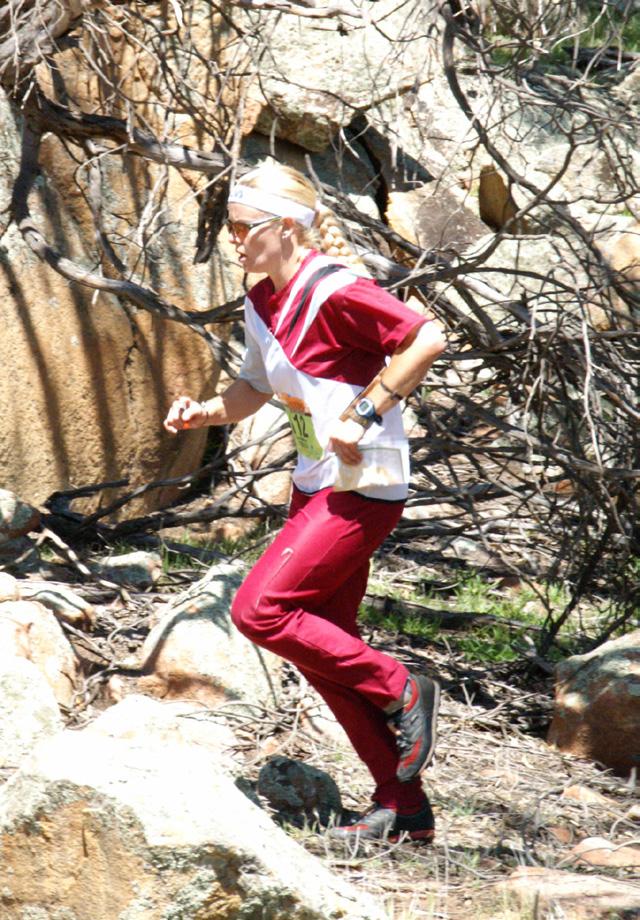
Riorden Dose at full speed at the Australian Relays. Vanessa Round, showing the affects of the local vegetation during the WA Champs.
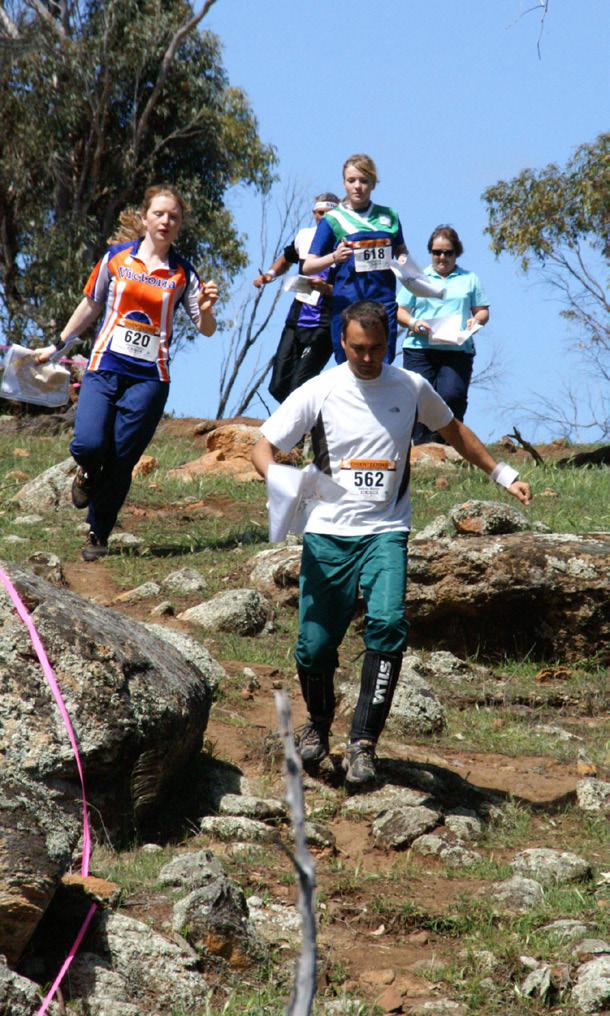
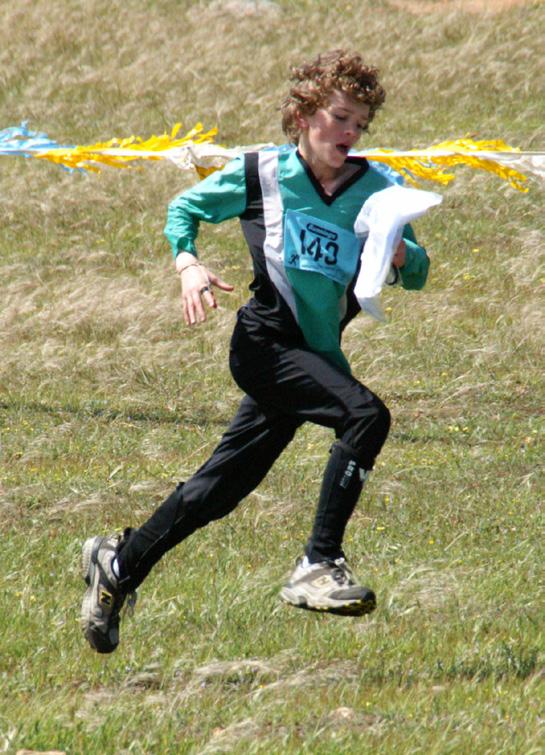
On the way to the Long Champs start triangle.
1: 15 000 5m contours
Australian Long Distance Champs 2006 Hill Park Dale, WA W21E 9.5km 385m climb Anna Sheldon
1 My initial thought was to go back up to the yellow, but from the triangle the straight option looked to be quite good running. Was careful to stay at the same height, and picked up the cliff south of the circle. I realised pretty quickly that the rock was going to be very hard to read on 1:15,000, and that anything that made it on the map was going to be big. 2 Tried to run pretty flat and pick up the big features on the early part of the leg to make the most of the yellow. Found Erin Post on the bare rock looking confused about the presence of an extra broken fence. Came into the circle a bit high and ended up in the rock on the south edge of the circle but relocated quickly. 3 The area coming off the track was a bit vague, so I was careful to stay on my compass line. Checked a flag on the cliff on the north edge of the circle, but then saw which cliff I needed on the line below. 4 Climbed gradually around the hill and crossed the track just below the green rocks. Came into the circle just about the big mound with the cliff. 5 Nearly lost it on this one. Ran on compass and was OK until near the circle, but expected the green knoll to the east to be more obvious. Relocated on the flag on the end of the line of rocks. 6 Decided to play it safe after the last one and use the bare rock above rather than risk the rocks and green below, and then found it really easily. 7 Straight across the bare rock and under the big cliff. Paused on top of the northern cliff to pick out the southern-most cliff with the boulder. 8 Across the top of the hill and along the bare rock to the white between the clumps of green and rocks. Dropped straight down the hill from there and picked up the bare-rock and cliff just above the control. 9 Ran to the left to avoid some junk at the start, then along the fence and straight up the hill. Went to the right coming into the control using the yellow and big rocks. Saw the control but took an extra 30sec to negotiate the thicket next to the bare rock to get close enough to punch. 10 Above the big rock and below the cliffs. Used the yellow area on the edge of the circle to figure out the line of rocks and the mound with the control. 11 Over the spur, avoiding the rock, and in around the cliff. 12 Spectator control which we’d all seen already. Bolted down the hill to the yellow area, avoiding the green and rocks. 13 Planned to keep running straight, but the rocks on the west side of the circle looked hard to get through, so round to the north and back in. 14 Careful compass on this leg to work out the different groups of rock. Used the big rocks to the north, and then just ran to the last rock before the yellow. 15 North of the green, then saw the flag as I came around the cliff. 16 The plan was to run along the top of the ridge, but it would have been better running to the east of #13 than the west. Ran to the pair of boulders near the fence and was very careful with my compass from there. Saw the other rocks and the cliff in the circle on the way in. Half-way along this leg I had that awful thought, “I’m nearly finished and I haven’t made any mistakes yet”, that usually means you’re about to fall into a navigational blackhole. Having visited that blackhole quite enough times before, I was extra careful on the last few controls! 17 Across the hill and then looked for the pair of rocks just past the peak of the spur. 18 Decided to run high and avoid the green at the end of the leg. Saw Briohny Davey and Kathryn as I came onto the bare rock and caught them at the control. Used the big rock in the green to check we were on line. 19 Staggered down the hill to the fence corner and into the last control.
-------- Anna Sheldon 76.55 -------- Jo Allison 79.39 -------- Kathryn Ewels 85.54
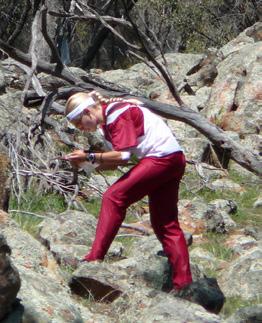
fields, and this year was no exception. There were eight within seven minutes of the lead in M16, but at the end of the day it was Lachlan Dow who emerged from the pack, as so often in the last couple of years, ahead of two first-time placegetters in Valentin Gafner and Julian Taylor. Claire Darvodelsky led all the way in W16, but at the end she was taken to the limit by two New Zealanders. Nicola Peat closed to within nine seconds at the end but could get no closer. The one win for the New Zealand juniors was by Laura Robertson in W14, whilst Todd Neve signalled that he might go on to be the best of the Neve siblings with a comfortable win in M14. The closest and most dramatic of the veteran classes was M60, which, as at Easter, saw some dramatic fluctuations at the business end. For two-thirds of the race it looked like John Brock would mark his return to national events with a comfortable win. He then lost six minutes at #9 to lose the lead, regained it when Tony Simpkins, Dave Lotty and Terry Bluett all had significant losses at #10 or #11, but then lost it again at the second-last control, dropping four minutes and four places. Simpkins and Lotty were separated by only two seconds at the last control, with the West Australian extending that to five in the chute for his first title. W45, as in most recent years, saw a high-standard contest featuring several former WOC representatives. Anthea Feaver, on home ground, gradually extended her lead over Liz Abbott in the second half to finish three minutes clear, whilst Jenny Bourne caught Carolyn Jackson late for third. Many of the other veteran women’s classes were dominated by a single individual. There were big wins for two international visitors, Patricia Aspin (nine minutes in W55) and Sharon Crawford (eight minutes in W60), but perhaps the most impressive was Robin Uppill, who put eleven minutes between herself and the rest of the W50 field. Paul Pacque looked as if he might be on his way to a similarly large margin when he led by nine minutes going into the secondlast control in M50, but almost managed to lose all of it there, just holding on against Eoin Rothery. It was at the other end of the course that Darryl Smith struck trouble in M45, and Mark Darvodelsky took control on the long 12th leg to win by three minutes. There were big wins for Jock Davis (M40) and Clive Pope (M70), Bob Allison led most of the way to score fairly comfortably in a large M55 field, and Hermann Wehner added to his record tally of national titles with his fourteenth win, in M80.
Australian Relays, Umuna, 8 October

The National League had long been decided by the time it came to Australian Relays day, but even without that context there were still some interesting races in store. Part of the context was the NSW battle with Victoria for second in the National League; Victoria needed to beat NSW in both races, preferably by some margin. Any chance of that set of results all but disappeared in the first half of the M21E relay. Far from being beaten by the Victorians, who were never in the hunt, NSW stayed with the heavy favourites, the Canberra Cockatoos, for most of the first two legs. Jock Davis showed that he is still very competitive over the shorter distances when he finished the first leg almost level with Gareth Candy, and Rob Preston stayed with Grant Bluett for most of the second leg. It was not until after the spectator control on the second leg that Bluett finally broke away, a break which was to prove decisive. Dave Shepherd took over with a lead of just under two minutes and ran right away with the race; indeed, NSW almost lost second as Kerrin Rattray brought South Australia home with a rush and nearly caught Julian Dent at the end. The Canberrans were as heavily favoured in W21E as in M21E. The only unexpected aspect of the day was that for the first half of the race it was their second team in front, thanks to an excellent first leg by Sophie Barker. By the end of the second leg Anna Quayle had put the first team in front, and they were never troubled thereafter with Jo Allison finishing off with the day’s fastest time. The most interesting contest was for the minor placings. Anna Sheldon, fresh from her win the day before, produced another fine run to take Queensland from fifth to second, whilst Kirsten Fairfax won a sprint finish with Cath Chalmers to complete the places. It was a good finish to a bad weekend for the Victorian team in general (who lost all their gear when their car was broken into on the Friday) and Fairfax in particular (who ended up in hospital on Saturday night after a draining Championship race). The elite races may not have seen a repeat of last year’s drama, but once again a race leader took a wrong map – this time it was the Tasmanian M17-20E team on the second leg. The impact was less severe – partly because the map they took was for a non-existent team, and partly because there was a second Tasmanian team, which was ultimately the leading state team against more fancied opposition. The three leaders went out together, with Jack Vincent bringing New Zealand in a minute ahead of the Tasmanians. In W17-20E, there was a solid win for the home state. Sarah Dunnage gave them a comfortable lead which they then lost to New Zealand on the second leg, but Kellie Whitfield turned the tables again to bring them home with four minutes to spare. The best of the other races were in the junior classes. In M16, where seven minutes covered the six leading teams, New Zealand and the ACT were fighting it out for the lead after two legs, but Scott McDonald gave the New Zealanders the win, and a great last leg by Oscar Phillips saw the Tasmanians fall just short of second. New Zealand also won W16 in the day’s closest result. It looked like it might be a Kiwi 1-2 after two legs, but the New Zealand second team dropped away, and instead Catherine Hewitt almost came over the top of both of them for Tasmania, missing out by a mere 11 seconds. None of the veteran classes were particularly close, nor did any see a final-leg lead change – instead the recurring theme was that of a big lead being cut to a not-quite-so-big lead on the last leg – but the honours were spread around, with only Tasmania missing out and only New South Wales winning two classes. Probably the best performances were turned in by New South Wales in M60 and Western Australia in W45, both of whom won by nine minutes against decent opposition, whilst noteworthy runs included the lead-off legs of Patricia Aspin (W55), Jenny Bourne (W45) and Bob Allison (M55), and Paul Pacque’s last leg which brought the Tasmanians up to second in M45.
Photo: Troy Merchant
NUTRITION Buy yourself a JET for Christmas
JET compasses have the unique super-fast “Rare Earth” broad magnetic needle for the fastest settling and stability when running over rough terrain. Guaranteed to save precious seconds every time you check your bearing.
says Grant Bluett who runs with a Silva 6 Jet Spectra
SILVA 6 JET SPECTRA
For competitive orienteers who prefer the ultimate in thumb compasses. Features the broad fluorescent Jet needle and the unique time saving ‘Spectra’ colour coded ring. Elastic thumb strap and rubber pad for a safe and sure grip. Map scales in 1:10,000 and 1:15,000. Available in left and right hand models.
$138 from your local O-gear shop at events.

SILVA 5 JET
Features a scratch resistant ‘comfort-fit’ curved back-end baseplate and the unique fluorescent red/white, broad Jet needle. Easy-to-grip housing with enlarged dial. Detachable map scales in 1:15,000 and 1:10,000 and silicon baseplate feet to prevent unintentional slipping on maps. $133 from your
local O-gear shop at events.

SILVA 1S JET
Same high-performance Jet needle as in above model. Large magnifying lens in baseplate for enlarging fine map detail. Other features as in 5 Jet. $145
from your local O-gear shop at events.






